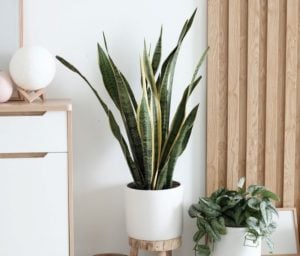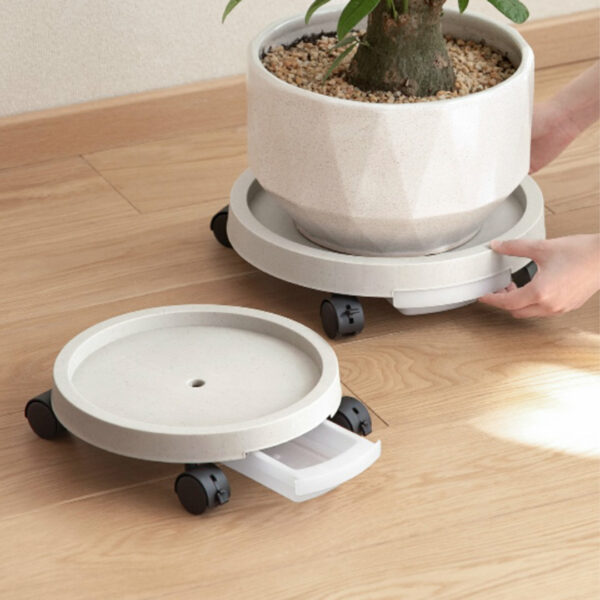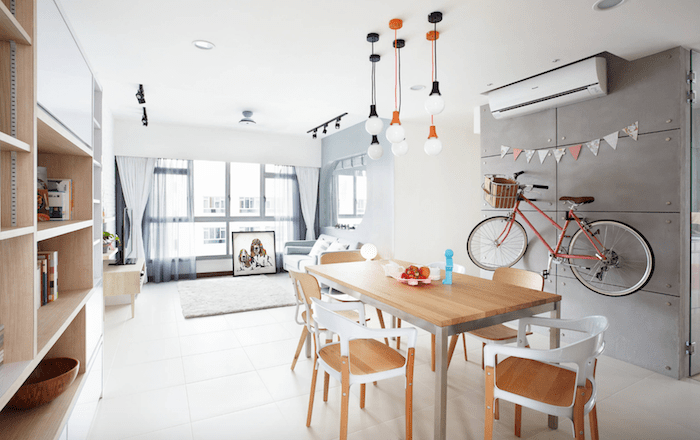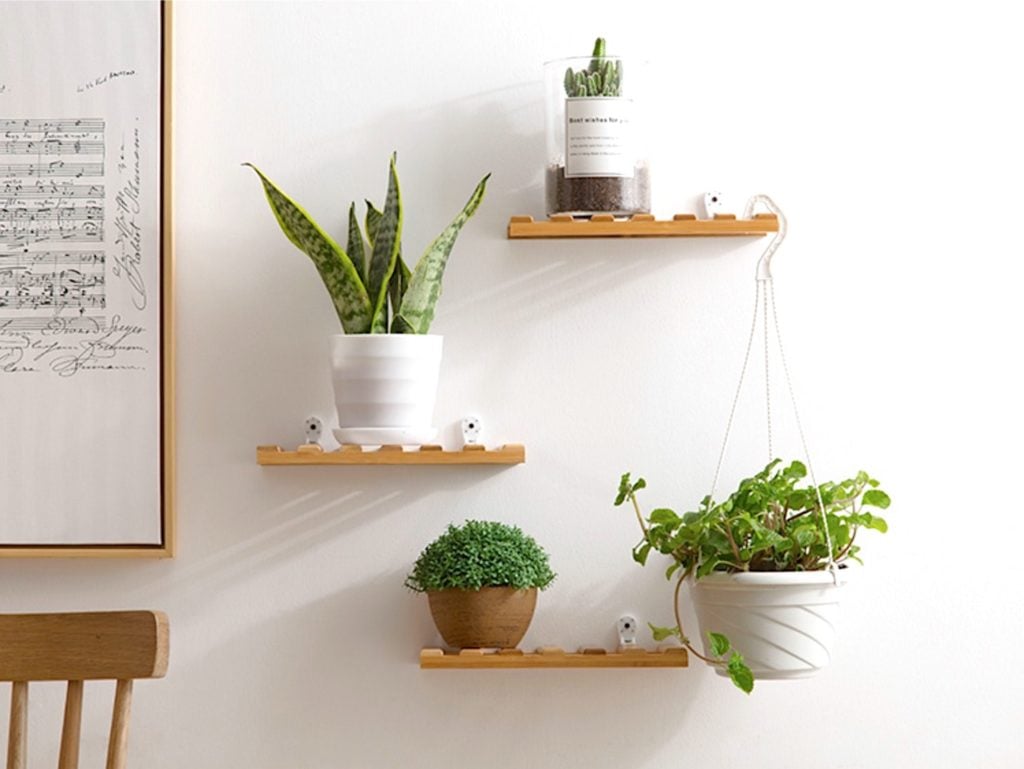Looking to welcome a new indoor plant to your home but unsure what’s the best for you? We’re here to help dispel any seeds of doubt!
From requiring only low levels of maintenance, to having air purifying properties and being perfect for your bathroom, we list out some great indoor plants for your home. Additionally, if you’re looking to grow an edible garden at home involving bean sprouts and onions, we’ve got your back too!
Have your eye out for an indoor plant with particular properties? Click on any of the links below to jump right in.
- Indoor Plants That Purify Air & Are Suitable For The Bathroom
- Low Maintenance Indoor Plants
- Where To Buy Plants Online In Singapore
- Edibles That Are Easy To Grow
Indoor Plants That Purify Air & Are Suitable For The Bathroom
Our environment harbours many impurities that can be harmful to the human body over time. For instance,
- Benzene may be found in homes as it exists in some adhesives and cleaning products
- Formaldehyde and ammonia naturally occurs in the environment due to cell metabolism in all living beings
According to the Ministry of Transport, 50% of the fine particulate matter in our environment exists due to emissions from vehicle exhaust. They include carbon dioxide, hydrocarbons, carbon monoxide and nitrogen oxides. For those who live near an expressway or MRT line, the convenience of these infrastructure being near your home may actually be negatively impacting air quality in the area.
However, there are plants that are capable of ridding the air of harmful oxides and pollutants through its natural processes. Consider introducing these to your home for fresher air!
1. Snake plant

With its tall and upright leaves, the distinctive snake plant is sometimes also known as ‘mother-in-law’s tongue’ and ‘Saint George’s sword’.
The simple yet elegant look of the snake plant has made it a favourite in homes. It can grow between 30 to 240 centimetres in height and 15 to 90 centimetres in width.
During the daytime, this plant is capable of filtering harmful oxides and pollutants (benzene, formaldehyde and xylene) from the environment. And at night, it’ll offer you restful sleep by converting carbon dioxide into oxygen.
This plant is extremely hardy, so feel free to pop this anywhere at home, from your nightstand to your bathroom!
How to care for a snake plant
Another plus point of the snake plant would be how low maintenance it is. It does fine in both bright and dark spots, on minimal watering.
Thanks to its succulent leaves, the snake plant only needs water once a month. Water thoroughly until the soil is damp, and then be sure to keep the soil dry in between watering sessions.
2. Peace lily plant

Image source: Green and Vibrant
For those who want a low maintenance and flowering plant, the peace lily will offer you the best of both worlds.
This white-blossomed beauty is delightfully easy to care for, and gives you fresher air by removing five toxins (benzene, formaldehyde, trichloroethylene, xylene and ammonia) from your living space.
How to care for a peace lily plant
Keep those white blossoms looking perky by watering your peace lily once a week. Let it rest somewhere with moderate partial sunlight, such as by the window or balcony.
Because it thrives in a low-light setting, it’ll also do fine in your bathroom!
3. Parlor palm

Image source: Smart Garden Guide
For those who are going for a tropical vibe at home, the parlor palm is a good place to start. This is a low maintenance houseplant that’ll bring freshness to your living space with its deep green fronds and blade shaped leaves.
What’s even more impressive, is that the parlor palm has a stamp of approval from NASA researchers as one of the best air cleaning plants to remove pollutants such as formaldehyde, benzene and carbon monoxide from the environment.
How to care for a parlor palm
Parlor palms are happy in a low light setting, but provide them with some bright, filtered sunlight (such as by the window) to give their growth an extra boost. Avoid direct sunlight, which could fry its delicate fronds.
Be mindful with watering a parlor palm as they develop rot when waterlogged. Water only when the top inch of soil feels dry, or if you observe yellowing at the ends of the leaves. Ensure that there is a good drainage system going as well.
If well taken care of, expect a plant of up to 3 to 4 feet tall!
Low Maintenance Indoor Plants
Want to bring some greenery home but afraid of commitment? We’ve compiled some of the hardiest plants that won’t wilt if you don’t give them tender loving care every day.
With no need to worry about complicated pruning or excessive watering, sit back and enjoy these eight forgiving indoor plants!
4. Monstera plant

Don’t let its name frighten you, this lovely plant is favoured for its gentle drooping leaves that are shaped like hearts.
Splits and holes in the leaves of the monstera plant have also earned it the name ‘swiss cheese’ plant, that effortlessly brings a touch of detail and elegance to your home.
Monstera can get heavy and grow out of control. Place it on a rollable plant platform to solve this issue and you can relocate it anywhere you like in your home!
-
 Rollable Plant Pot Platform (With Drainer)$13.80 – $16.80
Rollable Plant Pot Platform (With Drainer)$13.80 – $16.80
How to care for a monstera
Keep your monstera away from direct sunlight as its leaves may burn, and water it once a week. To get your monstera looking its best, offer it some bright filtered light as well.
In addition, the monstera is a fairly large plant, so be sure to give it room to grow, such as in your living room.
Note: If you have pets (especially cats) and young kids at home, give this plant a miss as Monsteras are highly toxic to them once nibbled on.
5. Succulents

Image source: hello glow
Looking for a tiny and adorable potted plant for your desk? Succulents fulfil that in every regard!
The ever-increasing popularity of succulents can be chalked up to the many variations available to suit each individual’s preferences. Some have fleshy and pulpy leaves, while others flower sporadically throughout the year. You can also get a little potted cactus or aloe vera.
How to care for a succulent
Succulents don’t require much sun or water, as they store water in their stems, roots and leaves. Water your succulent every 10 to 14 days, adjusting your watering schedule as necessary based on your plant.
Be sure to also keep it well drained with drainage holes in the base of your planting pot. Succulents may burst when oversaturated!
Note: Stay away from cacti or prickly species of succulent if you have kids or pets wandering about at home.
6. Money plant

Image source: Spruce
With its adorable round and glossy leaves, money plants make for great indoor decor. This fast-growing plant can reach heights and lengths of 30 centimetres if well taken care of.
The money plant is also a popular choice for those who are believers of feng shui, as it is said to bring wealth and luck to your entire family.
This is definitely a plant one would want at home!
Also check out on StyleMag: 4 Easy Feng Shui Tips: A Guide For New Homeowners & Beginners
How to care for a money plant
Because the money plant reaches out towards sunlight when growing, rotate the plant twice a week to prevent slanting of its stem. Keep it out of the sun as well as its leaves are prone to scorching. Water once every 7 to 10 days.
7. Aloe vera plant

Image source: Pinterest
If you’ve been scouting for an indoor plant for a while now, the aloe vera has probably popped up as a suggestion quite a few times, and for good reason! Besides its aesthetically pleasing look, the aloe vera requires little maintenance to flourish, making it a popular choice with homeowners.
The pulp of aloe vera is also a tasty topping in many desserts and drinks, and works as a treatment for minor burns and rashes too!
How to care for an aloe vera
Aloe vera is a sun-loving plant that requires bright lighting, of which we have aplenty in sunny Singapore. It also only requires watering once a week.
Ensure that its pot has drainage holes for excess water to flow out. You’ll also want to allow the soil to dry completely before watering it again.
Don’t be overzealous when it comes to watering your aloe. An oversaturated aloe can burst or drown!
8. String of pearls plant

Image source: iStock
The string of pearls plant has an elegant name and an even more elegant appearance to match. With its long cascading strands of beads, it’ll bring a quirkiness to your home that you’ll be completely enamoured with.
To best showcase its beauty, you’ll want to pot it in a hanging basket or let it perch somewhere where its beads can trail down.
How to care for a string of pearls plant
Give your string of pearls plant bright light, but not direct sunlight which can cause burning.
This plant stores moisture in its fleshy beads so you should not be overzealous with watering. Only water once its topsoil has had some time to dry out, which can be estimated as every 10 to 14 days.
Feeling overwhelmed by all the choices? We’ve summarised these 8 plants and their care tips into a simple infographic to help you make your final decision!

Where To Buy Plants Online In Singapore
Feeling inspired to bring a potted beauty home? Here’s a list of places where you can purchase indoor plants in Singapore.
- Far East Flora: Perhaps the most well-known plant nursery in Singapore, from plants, to pots, to workshops, they’ve got you covered. Purchase plants online or visit one of their outlets.
- Candy Floriculture: Offers a wide range of plants as well as essential supplies such as pot stands and fertilisers to help you keep your plant looking its best. Purchase plants online or visit them at 567 Thomson Road Singapore 298183.
- The Garden Store: Provides an affordable range of plants, gardening products and more. Thanks to their convenient online store, you’ll be able to search for a plant by height, size and even colour. Purchase plants online or visit them at No. 10 Bedok South Road, Singapore 469274.
- Tumbleweed Plants: Carefully curated plants that are display-ready, with aesthetic plants potted in complementary pots. Their plants are all suitable for the indoors and they are more than happy to offer advice on how to care for them! Purchase plants online or visit them at #01-02, 55 Tiong Bahru Road, Singapore 160055.
- FittoniaMania: With over 300 indoor plants and even potted terrariums for you to choose from, you’ll have a great chance of finding an aesthetic addition for your home! Purchase plants online or visit one of their outlets.

Shop our range of Home & Garden Essentials here too!
Edibles That Are Easy To Grow
Since you’re looking to bring some greenery into your home, you can consider making the most of it by planting some edible options so you’ll always have fresh vegetables and herbs for your family.
We share some ideas for planting some hardy vegetables and herbs indoors, and how you can be eco-friendly by potting them in recycled materials.
9. Bean sprouts
If you’re a big fan of bean sprouts, or simply want to give gardening a go, getting mung beans (also known as green beans) to germinate can be a great starting project. For those with kids, it’s also a chance to let them apply what they’ve learnt in science classes to real life.
What you need to get started is simply:
- Mung beans (Note that organic mung beans will produce thinner sprouts while regular mung beans yield thicker results)
- An empty bottle or container (get a large one as the bean sprouts will grow and fill the space quickly)
Once you have all those materials, it’s time to get growing.
- Soak mung beans in an empty bottle/container for at least 6 hours or overnight.
- Pour away the excess water and sift out any broken beans after.
- Spread mung beans in your bottle/container and cover it with a piece of cloth to prevent it from getting exposed to any light. Keep it from sunlight as it will cause the sprouts to redden.
- From the next 2-4 days, water the beans twice daily, morning and night. Always pour out the excess water after watering.
- Wait 5 days, and then harvest your bean sprouts. Enjoy!
10. Onion

Image source: Pinterest
Onions are a common ingredient in many dishes and the spring onion is often used as a flavourful garnish in many Asian dishes, like soup. For those who love adding spring onion to your meals, you can easily derive fresh onion leaves from the comforts of your home by planting a sprouted onion bulb.
This is especially useful for those who are always discovering sprouts in their onions. Although they are safe to consume, if you feel that you would rather not eat sprouted onions, you can consider planting them for some great greens.
To plant your sprouted onion bulb:
- Prepare a pot between 8 to 12 inches in size.
- Fill the pot with soil, and leave a couple of inches of space at the top.
- Make a hole the size of an onion in the centre of the soil.
- Carefully put a healthy-looking sprouted onion into the pot and then cover with soil such that the base of the sprouted shoots are touching the surface of the soil.
- Press down gently but firmly on the soil to get rid of air pockets.
How to care for an onion plant
Take care of your onion bulb by giving it plenty of water, but be sure to provide drainage holes for excess water to run out of. You’ll also have to leave them in a shaded spot for a few weeks so that the roots can adjust and grow.
After a couple of weeks, you can start to gradually introduce them to more sun, from partial to full.
While the bulb may only be ready to harvest after approximately 8 weeks, you’ll be able to harvest its shoots every 5 to 7 days as they grow, so let that tide you over as you wait!
11. Garlic
In a similar fashion, sprouted garlic can also be potted just as sprouted onion can be. Instead of leaves, you’ll be harvesting garlic bulbs in the soil.
To plant your either a sprouted or unsprouted garlic clove:
- Prepare a pot between 8 to 12 inches in size.
- Fill the pot with soil, and leave a couple of inches of space at the top.
- Make a hole the width and depth of a garlic clove in the centre of the soil.
- Carefully put a healthy-looking garlic clove into the pot and then cover with soil. If the clove has sprouted, ensure that the base of the shoots are touching the surface of the soil. Place unsprouted cloves about half an inch beneath the surface, with its pointy end facing upwards.
- Press down gently but firmly on the soil to get rid of air pockets.
How to care for a garlic plant
Saturate the soil with water until the excess drains from the drainage holes in the base of your pot. Ensure that the soil stays wet throughout the growing process. Garlic also needs lots of full sun.
Snip off any shoots or flowers that appear so that more energy can be focused towards developing a larger garlic bulb.
After 8 months, or when the tops of most of the garlic’s leaves have turned yellow, you’ll be able to harvest your garlic!
12. Ginger

Image source: Top Inspired
Spice things up at home with a good dose of nutritious ginger. You’ll find that you can grow some juicy golden roots at home by following these simple steps.
- Prepare a piece of ginger with a protruding ‘eye’ on it. Ensure that the piece isn’t too small or else there won’t be a good yield of ginger.
- Fill a pot with at least 4 inches worth of soil, depth and width wise. You’ll have to top up the soil as the ginger grows.
- Plant your piece of ginger with the ‘eye’ facing upwards.
- After 9 months, your ginger will be ready for harvesting!
How to care for a ginger plant
Keep your ginger happy by giving it lots of sun, which we have plenty of in Singapore. Keep its soil wet, but ensure that there are drainage holes in the base of your pot for excess moisture to flow.
Some additional tips would be that you should lessen the amount of water you give your ginger plant when there are no leaves to prevent rotting. Providing your plant with a bigger and wider pot will also yield more ginger!
13. Mint

Image source: Herbs at Home
Unique for its refreshing scent and taste, mint is one of the easiest herbs to grow thanks to its fast growth rate. Once harvested, you’ll have a regular supply of mint leaves for garnish, beverages and more!
In addition, a mint plant also has some pretty neat mosquito repelling effects. The essence in its roots, leaves and flowers are unpleasant to mozzies, and if you have an itchy bite, menthol in mint leaf juice can aid in offering relief as well.
Also check out on StyleMag: Natural & DIY Mosquito Repellents To Keep Dengue Away
To start growing your own mint plant, you can either buy a pot of mint or mint seeds from the supermarket or a plant nursery. If you’re lucky and have a friend or neighbour who is already growing mint, you can try asking them for a cutting to get you started.
How to grow mint from cuttings:

Image source: Laurence Manchee
Start your new plant from a cutting by removing all the leaves on your cutting except for the two tiny leaves right at the top. Place the stem into water and change its water daily until roots grow. Roots typically take about a week to appear.
If long straggly stems appear, bend or cut them off. Pot your mint cutting’s roots into soil and soon it’ll grow into a mint plant!
How to care for a mint plant
Trim your mint plant regularly while it’s growing to boost growth and give its lots of sun. You should give your mint plenty of water, but make sure to have drainage holes at the base of your pot for excess water to flow out.
You may also want to keep your mint in an isolated pot as it grows fast and may take over the space and nutrients of other plants if placed in a shared pot.
If you’ve got some spare plastic bottles lying around and want to give upcycling a go, why not use those bottles to create some really cute plant pots? Here’s a simple tutorial to help you out:
Also check out on StyleMag: Upcycle These Household Items For A Zero Waste Home
14. Celery

Image source: lakopi.sg
A particularly beneficial food for those suffering from gout, growing more celery from your store-bought stalk is a very simple process.
Cut off about 3 inches of the bottom of your celery and poke through it with sticks to suspend it over a container with water, as seen in the image above. Make sure that the celery’s roots aren’t touching the base of the container so it has room to grow.
Leave the celery in a spot with ample sunlight and you should start to see a new celery sprouting from the centre of the base after one to two weeks. You can then repot it in soil.
How to care for a celery plant
Provide your celery plant with abundant sunlight after repotting. Also ensure that the soil remains damp by watering it twice a day.
Here’s a simple summary of these 6 edibles and their maintenance tips in an infographic.

“The love of gardening is a seed once sown that never dies.” Gardening can be a therapeutic and fulfilling hobby, so we wish you happiness and joy in your journey to cultivate the perfect home garden!
We hope these indoor plant ideas have been useful, both for budding gardeners and seasoned enthusiasts alike. Let us know what’ll be blossoming in your home in the comments down below.
Enjoyed this post? Join us on Instagram @style_degree, Facebook and Telegram @HomeownersSG, where we share the best home organization tips and cleaning hacks to help you embark on an organized and happier homeowner life! P.S You’ll be the first to learn about our latest product launches there too.













